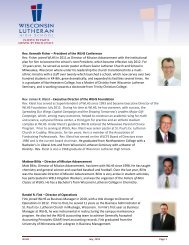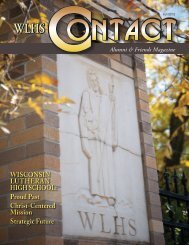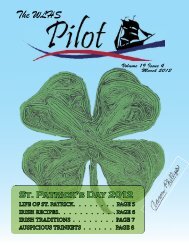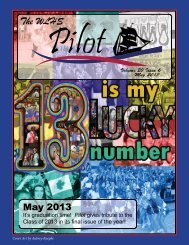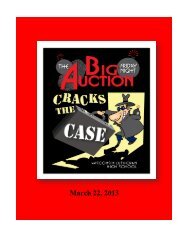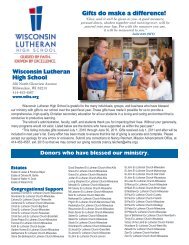Tim Thierfelder tim.thierfelder@wlhs.org 453-4567 x - Wisconsin ...
Tim Thierfelder tim.thierfelder@wlhs.org 453-4567 x - Wisconsin ...
Tim Thierfelder tim.thierfelder@wlhs.org 453-4567 x - Wisconsin ...
Create successful ePaper yourself
Turn your PDF publications into a flip-book with our unique Google optimized e-Paper software.
WISCONSIN LUTHERAN HIGH SCHOOL 2011-2012ADVANCED ALGEBRA AInstructor: <strong>Tim</strong> <strong>Thierfelder</strong> <strong>tim</strong>.<strong>thierfelder@wlhs</strong>.<strong>org</strong> <strong>453</strong>-<strong>4567</strong> x 1323TEXTBOOK: Algebra 2: Applications, Equations, and Graphs (McDougal, Littell,2001)COURSE PURPOSEAdvanced Algebra A is a continuing study in the language of mathematics. Students inAdvanced Algebra A will continue to see the greatness of God in ordering our universe.Knowledge and skills gained in this course will allow students to continue their path in Christcenteredliving as they prepare for college. Completion of Advanced Algebra A preparesstudents to continue their study of mathematics in Trigonometry and Precalculus.COURSE OUTCOMESIn Advanced Algebra A, students will:1. demonstrate understanding of God’s creation by solving real-life problems.2. demonstrate <strong>org</strong>anizational and notetaking abilities in notebook form.3. demonstrate responsibility by turning in completed homework in a <strong>tim</strong>ely fashion.4. demonstrate mastery of algebra concepts and techniques in functions, polynomials, complexnumbers, quadratic equations and symbolic manipulation.5. demonstrate ability in analysis and critical thinking skills in both written and oral form.6. demonstrate integration of technological strategies into problem solving.COURSE GOALS1. The students will show their commitment to serve God by always beingprepared.2. The students will show their commitment to serving each other by beinghelpful when working in a group setting.3. The students will be able to communicate mathematically at an AdvancedAlgebra A level by orally explaining a problem solving process.4. The students will be able to communicate mathematically at a anAdvanced Algebra A level by writing solutions to algebraic and geometric questionsaccording to standardized format as shown in the textbook.5. The students will become more adept at open ended problem solving through assigned classproblems and participation in math track competitions.
COURSE OUTLINEUnit One: Equations and Inequalities-use the real number line and the properties of real numbers-evaluate and simplify algebraic expressions-solving linear equations and using the same in real life-rewriting an equation with more than one variable and applyingcommon formulas-using a problem solving plan-solving linear inequalities and compound inequalities-solving absolute value equations and inequalitiesTextbook: pages 3-55 Number of days: 10-14 S.O. 2, 4, 6 D.O. 1.1,2.1,4.2M.C.S. A-CED.1, A-CED.4, A-REI.3, N-RN.3Unit Two: Linear Functions-identifying, graphing, and evaluating functions-finding slopes of lines and using slope in real life-using the slope-intercept form and the standard form of theequations of lines-writing equations of lines and writing direct variation equations-using scatter plots and correlation, approximating best fitting lines-graphing linear inequalities and using them in real life-representing piecewise functions and absolute value functionsTextbook: pages 67-127 Number of days: 13-15 S.O. 2, 4, 6 D.O. 2.1, 3.1, 3.3M.C.S. A-REI.10, F-IF.1, F-IF.2, F-IF.5, F-IF.6, S-ID.6, S-ID.7, S-ID.8.Unit Three: Linear Systems-graphing and solving systems of linear equations-solving a system of linear inequalities by substitution and linear combination-graphing a system of linear inequalities-using linear programming-graphing in three dimensions-solving a system in three variablesTextbook: pages 139-183 Number of days: 9-11 S.O. 2, 4, 6 D.O. 2.1, 3.3, 4.2M.C.S. A-CED.2, A-CED.3, A-REI.5, A-REI.6, A-REI.12Unit Four: Matrices-using matrix operations, multiplying matrices-evaluating determinants of a 2x2 and a 3x3 matrix and applicationof Cramer’s rule to the same-identifying and using inverse matrices-solving systems of equations with matricesTextbook: pages 199-263 Number of days: 10-13 S.O. 2, 4, 6 D.O. 2.1, 3.1, 4.2M.C.S. A-REI.8, A-REI.9, N-VM.6, N-VM.7, N-VM.8, A-REI.8, N-VM.9, N-VM.10, N-VM.12Unit Five: Quadratic Functions-graphing quadratic functions in the vertex form and in the intercept form-factoring quadratic expressions and finding zeros of quadratic functions-solving quadratic equations by finding square roots
-operations with complex numbers- solving quadratic equations by completing the square-using the discriminant and solving vertical motion problems-graphing quadratic inequalities in two variables-solving quadratic inequalities in one variable-writing quadratic functions given characteristics of their graphs-use technology to find quadratic models for dataTextbook: pages 249-311 Number of days: 15-18 S.O. 2, 4, 6 D.O. 2.1,3.1,3.3M.C.S. A-SSE.3, A-APR.3, A-REI.4, A-APR.3, N-CN.1, N-CN.2, N-CN.3, N-CN.7, N-CN.9, A-APR.5Unit Six: Polynomials-using properties of exponents-evaluating and graphing polynomial functions-add, subtract and multiply polynomials-factor polynomial expressions, using factoring to solve polynomial equations-dividing polynomials with long division and synthetic division-using the factor and remainder theorems-using the rational root theorem to find roots of polynomial equations-determining the numbers of roots in polynomial function with the fundamentaltheorem of algebra-using the graphing calculator to approximate the real zeros of a function-analyze the graph of a polynomial function-maximize the volume of a box-using finite differences to determine the degree of a polynomial functionTextbook: pages 373-385 Number of days: 16-19 S.O. 2, 4, 6 D.O. 2.1, 3.1, 3.3, 4.2M.C.S. A-SSE.1, A-SSE.2, A-APR.1, A-APR.2, A-APR.3, A-APR.4, A-APR.5, A-APR.6, F-IF.4, F-IF.7, F-BF.3Unit Seven: Powers and Roots-evaluating nth roots of real numbers-using the properties of rational exponents to evaluate and simplify expressions-perform operations with power functions-finding inverses of linear and non-linear functions-performing composite function operations-graphing cube root and square root functions-solve radical equations-use measures of central tendency to describe data sets-use box-and-whisker plots to represent data graphicallyTextbook: pages 401-452 Number of days: 15-18 S.O. 2, 4, 6 D.O. 2.1, 3.3, 4.2M.C.S. A-SSE.3, F-BF.1, F-BF.3, F-BF.4, N-RN.1, N-RN.2Unit Eight: Exponential & Logarithmic Functions-graphing exponential growth and decay functions-applying the same to real life-use the number e as a base of an exponential function-evaluating and graphing logarithmic functions-using properties of logarithms-solving exponential and logarithmic equations-model data with exponential functions and with power functions-evaluate and graph logistic growth functionsTextbook: pages 465-521 Number of days: 15-17 S.O. 2, 4, 6 D.O. 1.2, 2.2, 3.1M.C.S. F-BF.5, F-LE.2, F-LE.3, F-LE.4, S-ID.6, F-IF.8.b
Unit Nine: Rational Equations and Functions-write and use inverse (and joint) variation models-graphing simple rational functions-graph general rational functions-multiply and divide rational expressions-adding and subtracting rational expressions-simplifying complex fractions-solving rational equationsTextbook: pages 589-640 Number of days: 13-16 S.O. 2, 4, 6 D.O. 4.2, 4.4, 5.3M.C.S. A-REI.2, A-REI.11Unit Ten: Conic Sections-using the distance and midpoint formulas-graph and write equations of parabolas- graph and write equations of circles- graph and write equations of ellipses- graph and write equations of hyperbolas- graph and write equations translated conic sections-solve a system of quadratic equations-use a system of quadratic equations to solve real life problemsTextbook: pages 589-640 Number of days: 15-18 S.O. 2, 4, 6 D.O. 4.2, 4.4, 5.3M.C.S. A-REI.7, G-GPE.1, G-GPE.2, G-GPE.3, G-GMD.4Unit Eleven: Sequences and Series-identify Arithmetic sequences and series- identify Geometric sequences and series- compute sequences and series- utilize infinite Geometric series- use recursive rules for sequencesTextbook: pages 589-640 Number of days: 10-12 S.O. 2, 4, 6 D.O. 1.2, 2.1, 3.1M.C.S. A-SSE.4, F-IF.3, F-BF.2, F-LE.2INSTRUCTIONAL STRATEGIESLecture/board presentations 80%Individual, Group work on problems 20%GRADINGThe following standards for homework completion will be adhered to:-All homework will completed by the next class period-All steps will be shown as in the textbook examples-If unable to solve a problem, document thethe facts and your attempts-Homework will improve your grade indirectly by increasingyour skills, resulting in higher test scoresTests : 70%Daily Homework: 30%Sem. Grade=.35(1st Q) + .35(2nd Q) + .3(Final)
-APPENDIX-Advanced Algebra-<strong>Tim</strong> <strong>Thierfelder</strong>Department OutcomesUnit One: Equations and Inequalities1.1 A God-centered thinker who distinguishes the proper place and role ofMathematics in their mission to serve God2.1 An innovative thinker who develops a repertoire of problem solvingtechniques4.2 An effective communicator who documents a logical sequence of symbolicmanipulationUnit Two: Linear Functions2.1 An innovative thinker who develops a repertoire of problem solvingtechniques3.1 A decision maker who integrates the use of mathematics into other academicand real-life areas3.2 A decision maker who is capable of effectively using technology as a tool forproblem solvingUnit Three: Linear Systems2.1 An innovative thinker who develops a repertoire of problem solvingtechniques3.3 A decision maker who is capable of effectively using technology as a toolfor problem solving4.2 An effective communicator who documents a logical sequence of symbolicmanipulationUnit Four: Matrices2.1 An innovative thinker who develops a repertoire of problem solvingtechniques3.1 A decision maker who integrates the use of mathematics into other academicand real-life areas4.2 An effective communicator who documents a logical sequence of symbolicmanipulationUnit Five: Quadratic Functions2.1 An innovative thinker who develops a repertoire of problem solvingtechniques3.1 A decision maker who integrates the use of mathematics into other academicand real-life areas3.3 A decision maker who is capable of effectively using technology as a toolfor problem solving
-APPENDIX (department outcomes continued)Unit Six: Polynomials2.1 An innovative thinker who develops a repertoire of problem solvingtechniques3.1 A decision maker who integrates the use of mathematics into other academicand real-life areas3.3 A decision maker who is capable of effectively using technology as a toolfor problem solving4.2 An effective communicator who documents a logical sequence of symbolic manipulationUnit Seven: Powers and Roots2.1 An innovative thinker who develops a repertoire of problem solvingtechniques3.3 A decision maker who is capable of effectively using technology as a toolfor problem solving4.2 An effective communicator who documents a logical sequence of symbolic manipulationUnit Eight: Exponential & Logarithmic Functions1.2 A God-centered thinker who recognizes God’s logical order and expressionin creation as evidenced by the structure of mathematics2.2 An innovative problem solver who produces beneficial and God-pleasingsolutions to the diversity of real-life problems3.1 A decision maker who integrates the use of mathematics into other academicand real-life areasUnit Nine: Rational Equations and Functions2.1 An innovative thinker who develops a repertoire of problem solvingtechniques3.1 A decision maker who integrates the use of mathematics into other academicand real-life areas4.2 An effective communicator who documents a logical sequence of symbolic manipulationUnit Ten: Conic Sections2.1 An innovative thinker who develops a repertoire of problem solvingtechniques3.1 A decision maker who integrates the use of mathematics into other academicand real-life areas4.2 An effective communicator who documents a logical sequence of symbolic manipulationUnit Eleven: Sequence and Series1.2 A God-centered thinker who recognizes God’s logical order and expressionin creation as evidenced by the structure of mathematics2.1 An innovative thinker who develops a repertoire of problem solvingtechniques3.1 A decision maker who integrates the use of mathematics into other academicand real-life areas
Math Core StandardsUnit One: Equations and InequalitiesA-CED.1. Create equations and inequalities in one variable and use them to solve problems. Includeequations arising from linear and quadratic functions, and simple rational and exponential functions.A-CED.4. Rearrange formulas to highlight a quantity of interest, using the same reasoning as in solvingequations. For example, rearrange Ohm’s law V = IR to highlight resistance R.A-REI.3. Solve linear equations and inequalities in one variable, including equations with coefficientsrepresented by letters.N-RN.3. Explain why the sum or product of two rational numbers is rational; that the sum of a rationalnumber and an irrational number is irrational; and that the product of a nonzero rational number and anirrational number is irrational.Unit Two: Linear FunctionsA-REI.10. Understand that the graph of an equation in two variables is the set of all its solutions plotted inthe coordinate plane, often forming a curve (which could be a line).F-IF.1. Understand that a function from one set (called the domain) to another set (called the range)assigns to each element of the domain exactly one element of the range. If f is a function and x is anelement of its domain, then f(x) denotes the output of f corresponding to the input x. The graph of f is thegraph of the equation y = f(x).F-IF.2. Use function notation,evaluate functions for inputs in their domains, and interpret statements thatuse function notation in terms of a context.F-IF.5. Relate the domain of a function to its graph and, where applicable, to the quantitative relationshipit describes. For example, if the function h(n) gives the number of person-hours it takes to assemble nengines in a factory, then the positive integers would be an appropriate domain for the function. ★F-IF.6. Calculate and interpret the average rate of change of a function (presented symbolically or as atable) over a specified interval. Es<strong>tim</strong>ate the rate of change from a graph. ★S-ID.6. Represent data on two quantitative variables on a scatter plot, and describe how the variables arerelated.oob. Informally assess the fit of a function by plotting and analyzing residuals.c. Fit a linear function for a scatter plot that suggests a linear association.S-ID.7. Interpret the slope (rate of change) and the intercept (constant term) of a linear model in thecontext of the data.S-ID.8. Compute (using technology) and interpret the correlation coefficient of a linear fit.
Unit Three: Linear SystemsA-CED.2. Create equations in two or more variables to represent relationships between quantities; graphequations on coordinate axes with labels and scales.A-CED.3. Represent constraints by equations or inequalities, and by systems of equations and/orinequalities, and interpret solutions as viable or nonviable options in a modeling context. For example,represent inequalities describing nutritional and cost constraints on combinations of different foods.A-REI.5. Prove that, given a system of two equations in two variables, replacing one equation by the sumof that equation and a multiple of the other produces a system with the same solutions.A-REI.6. Solve systems of linear equations exactly and approximately (e.g., with graphs), focusing onpairs of linear equations in two variables.A-REI.12. Graph the solutions to a linear inequality in two variables as a half-plane (excluding theboundary in the case of a strict inequality), and graph the solution set to a system of linear inequalities intwo variables as the intersection of the corresponding half-planes.Unit Four: MatricesA-REI.8. (+) Represent a system of linear equations as a single matrix equation in a vector variable.A-REI.9. (+) Find the inverse of a matrix if it exists and use it to solve systems of linear equations (usingtechnology for matrices of dimension 3 × 3 or greater).N-VM.6. (+) Use matrices to represent and manipulate data, e.g., to represent payoffs or incidencerelationships in a network.N-VM.7. (+) Multiply matrices by scalars to produce new matrices, e.g., as when all of the payoffs in agame are doubled.N-VM.8. (+) Add, subtract, and multiply matrices of appropriate dimensions.N-VM.9. (+) Understand that, unlike multiplication of numbers, matrix multiplication for square matrices isnot a commutative operation, but still satisfies the associative and distributive properties.N-VM.10. (+) Understand that the zero and identity matrices play a role in matrix addition andmultiplication similar to the role of 0 and 1 in the real numbers. The determinant of a square matrix isnonzero if and only if the matrix has a multiplicative inverse.N-VM.12. (+) Work with 2 × 2 matrices as a transformations of the plane, and interpret the absolute valueof the determinant in terms of area.Unit Five: Quadratic FunctionsA-SSE.3. Choose and produce an equivalent form of an expression to reveal and explain properties ofthe quantity represented by the expression. ★ooa. Factor a quadratic expression to reveal the zeros of the function it defines.b. Complete the square in a quadratic expression to reveal the maximum or minimum value of thefunction it defines.A-APR.3. Identify zeros of polynomials when suitable factorizations are available, and use the zeros toconstruct a rough graph of the function defined by the polynomial.A-REI.4. Solve quadratic equations in one variable.
ooUse the method of completing the square to transform any quadratic equation in x into anequation of the form (x – p) 2 = q that has the same solutions. Derive the quadraticformula from this form.Solve quadratic equations by inspection (e.g., for x 2 = 49), taking square roots,completing the square, the quadratic formula and factoring, as appropriate to the initialform of the equation. Recognize when the quadratic formula gives complex solutions andwrite them as a ± bi for real numbers a and b.A-APR.3. Identify zeros of polynomials when suitable factorizations are available, and use the zeros toconstruct a rough graph of the function defined by the polynomial.N-CN.1. Know there is a complex number i such that i 2 = –1, and every complex number has the form a +bi with a and b real.N-CN.2. Use the relation i 2 = –1 and the commutative, associative, and distributive properties to add,subtract, and multiply complex numbers.N-CN.3. (+) Find the conjugate of a complex number; use conjugates to find moduli and quotients ofcomplex numbers.N-CN.7. Solve quadratic equations with real coefficients that have complex solutions.N-CN.9. (+) Know the Fundamental Theorem of Algebra; show that it is true for quadratic polynomials.A-APR A-APR.5. (+) Know and apply the Binomial Theorem for the expansion of (x + y) n in powers of xand y for a positive integer n, where x and y are any numbers, with coefficients determined for exampleby Pascal’s Triangle. 1Unit Six: PolynomialsA-SSE.1. Interpret expressions that represent a quantity in terms of its context. ★ooInterpret parts of an expression, such as terms, factors, and coefficients.Interpret complicated expressions by viewing one or more of their parts as a single entity. For example,interpret P(1+r) n as the product of P and a factor not depending on P.A-SSE.2. Use the structure of an expression to identify ways to rewrite it. For example, see x 4 – y 4 as (x 2 ) 2– (y 2 ) 2 , thus recognizing it as a difference of squares that can be factored as (x 2 – y 2 )(x 2 + y 2 ).A-APR.1. Understand that polynomials form a system analogous to the integers, namely, they are closedunder the operations of addition, subtraction, and multiplication; add, subtract, and multiply polynomials.A-APR.2. Know and apply the Remainder Theorem: For a polynomial p(x) and a number a, the remainderon division by x – a is p(a), so p(a) = 0 if and only if (x – a) is a factor of p(x).A-APR.3. Identify zeros of polynomials when suitable factorizations are available, and use the zeros toconstruct a rough graph of the function defined by the polynomial.A-APR.4. Prove polynomial identities and use them to describe numerical relationships. For example, thepolynomial identity (x 2 + y 2 ) 2 = (x 2 – y 2 ) 2 + (2xy) 2 can be used to generate Pythagorean triples.A-APR.5. (+) Know and apply the Binomial Theorem for the expansion of (x + y) n in powers of x and y fora positive integer n, where x and y are any numbers, with coefficients determined for example by Pascal’sTriangle. 1
A-APR.6. Rewrite simple rational expressions in different forms; write a(x) / b(x) in the form q(x) + r(x) / b(x) ,where a(x), b(x), q(x), and r(x) are polynomials with the degree of r(x) less than the degree of b(x), usinginspection, long division, or, for the more complicated examples, a computer algebra system.F-IF.4. For a function that models a relationship between two quantities, interpret key features of graphsand tables in terms of the quantities, and sketch graphs showing key features given a verbal descriptionof the relationship. Key features include: intercepts; intervals where the function is increasing, decreasing,positive, or negative; relative maximums and minimums; symmetries; end behavior; and periodicity. ★F-IF.7. Graph functions expressed symbolically and show key features of the graph, by hand in simplecases and using technology for more complicated cases. ★oc. Graph polynomial functions, identifying zeros when suitable factorizations areavailable, and showing end behavior.F-BF.3. Identify the effect on the graph of replacing f(x) by f(x) + k, k f(x), f(kx), and f(x + k) for specificvalues of k (both positive and negative); find the value of k given the graphs. Experiment with cases andillustrate an explanation of the effects on the graph using technology. Include recognizing even and oddfunctions from their graphs and algebraic expressions for them.Unit Seven: Powers and RootsA-SSE.3. Choose and produce an equivalent form of an expression to reveal and explain properties ofthe quantity represented by the expression. ★oc. Use the properties of exponents to transform expressions for exponential functions. For example theexpression 1.15 t can be rewritten as (1.15 1/12 ) 12t ≈ 1.012 12t to reveal the approximate equivalent monthlyinterest rate if the annual rate is 15%.F-BF.1. Write a function that describes a relationship between two quantities. ★ooCombine standard function types using arithmetic operations. For example, build a function that modelsthe temperature of a cooling body by adding a constant function to a decaying exponential, and relatethese functions to the model.(+) Compose functions. For example, if T(y) is the temperature in the atmosphere as a function of height,and h(t) is the height of a weather balloon as a function of <strong>tim</strong>e, then T(h(t)) is the temperature at thelocation of the weather balloon as a function of <strong>tim</strong>e.F-BF.3. Identify the effect on the graph of replacing f(x) by f(x) + k, k f(x), f(kx), and f(x + k) for specificvalues of k (both positive and negative); find the value of k given the graphs. Experiment with cases andillustrate an explanation of the effects on the graph using technology. Include recognizing even and oddfunctions from their graphs and algebraic expressions for them.F-BF.4. Find inverse functions.ooooSolve an equation of the form f(x) = c for a simple function f that has an inverse and write an expressionfor the inverse. For example, f(x) =2 x 3 or f(x) = (x+1)/(x–1) for x ≠ 1.(+) Verify by composition that one function is the inverse of another.(+) Read values of an inverse function from a graph or a table, given that the function has an inverse.(+) Produce an invertible function from a non-invertible function by restricting the domain.N-RN.1. Explain how the definition of the meaning of rational exponents follows from extending theproperties of integer exponents to those values, allowing for a notation for radicals in terms of rational
exponents. For example, we define 5 1/3 to be the cube root of 5 because we want (5 1/3 ) 3 = 5 (1/3)3 to hold,so (5 1/3 ) 3 must equal 5.N-RN.2. Rewrite expressions involving radicals and rational exponents using the properties of exponents.Unit Eight: Exponential & Logarithmic FunctionsF-BF.5. (+) Understand the inverse relationship between exponents and logarithms and use thisrelationship to solve problems involving logarithms and exponents.F-LE.2. Construct linear and exponential functions, including arithmetic and geometric sequences, givena graph, a description of a relationship, or two input-output pairs (include reading these from a table).F-LE.3. Observe using graphs and tables that a quantity increasing exponentially eventually exceeds aquantity increasing linearly, quadratically, or (more generally) as a polynomial function.F-LE.4. For exponential models, express as a logarithm the solution to ab ct = d where a, c, and d arenumbers and the base b is 2, 10, or e; evaluate the logarithm using technology.S-ID.6. Represent data on two quantitative variables on a scatter plot, and describe how the variables arerelated.ooa. Fit a function to the data; use functions fitted to data to solve problems in the context of the data. Usegiven functions or choose a function suggested by the context. Emphasize linear, quadratic, andexponential models.b. Informally assess the fit of a function by plotting and analyzing residuals.F-IF.8. Write a function defined by an expression in different but equivalent forms to reveal and explaindifferent properties of the function.ob. Use the properties of exponents to interpret expressions for exponential functions. For example,identify percent rate of change in functions such as y = (1.02)t, y = (0.97)t, y = (1.01)12t, y = (1.2)t/10, andclassify them as representing exponential growth or decay.Unit Nine: Rational Equations and FunctionsA-REI.2. Solve simple rational and radical equations in one variable, and give examples showing howextraneous solutions may arise.A-REI.11. Explain why the x-coordinates of the points where the graphs of the equations y = f(x) and y =g(x) intersect are the solutions of the equation f(x) = g(x); find the solutions approximately, e.g., usingtechnology to graph the functions, make tables of values, or find successive approximations. Includecases where f(x) and/or g(x) are linear, polynomial, rational, absolute value, exponential, and logarithmicfunctions. ★Unit Ten: Conic SectionsA-REI.7. Solve a simple system consisting of a linear equation and a quadratic equation in two variablesalgebraically and graphically. For example, find the points of intersection between the line y = –3x and thecircle x 2 + y 2 = 3.G-GPE.1. Derive the equation of a circle of given center and radius using the Pythagorean Theorem;complete the square to find the center and radius of a circle given by an equation.
G-GPE.2. Derive the equation of a parabola given a focus and directrix.G-GPE.3. (+) Derive the equations of ellipses and hyperbolas given the foci, using the fact that the sum ordifference of distances from the foci is constant.G-GMD.4. Identify the shapes of two-dimensional cross-sections of three-dimensional objects, andidentify three-dimensional objects generated by rotations of two-dimensional objects.Unit Eleven: Sequence and SeriesF-IF.3. Recognize that sequences are functions, some<strong>tim</strong>es defined recursively, whose domain is asubset of the integers. For example, the Fibonacci sequence is defined recursively by f(0) = f(1) = 1,f(n+1) = f(n) + f(n-1) for n ≥ 1.F-BF.1. Write a function that describes a relationship between two quantities. ★oooDetermine an explicit expression, a recursive process, or steps for calculation from acontext.Combine standard function types using arithmetic operations. For example, build afunction that models the temperature of a cooling body by adding a constant function to adecaying exponential, and relate these functions to the model.(+) Compose functions. For example, if T(y) is the temperature in the atmosphere as afunction of height, and h(t) is the height of a weather balloon as a function of <strong>tim</strong>e, thenT(h(t)) is the temperature at the location of the weather balloon as a function of <strong>tim</strong>e.F-BF.2. Write arithmetic and geometric sequences both recursively and with an explicit formula, use themto model situations, and translate between the two forms. ★F-LE.2. Construct linear and exponential functions, including arithmetic and geometric sequences, givena graph, a description of a relationship, or two input-output pairs (include reading these from a table).



